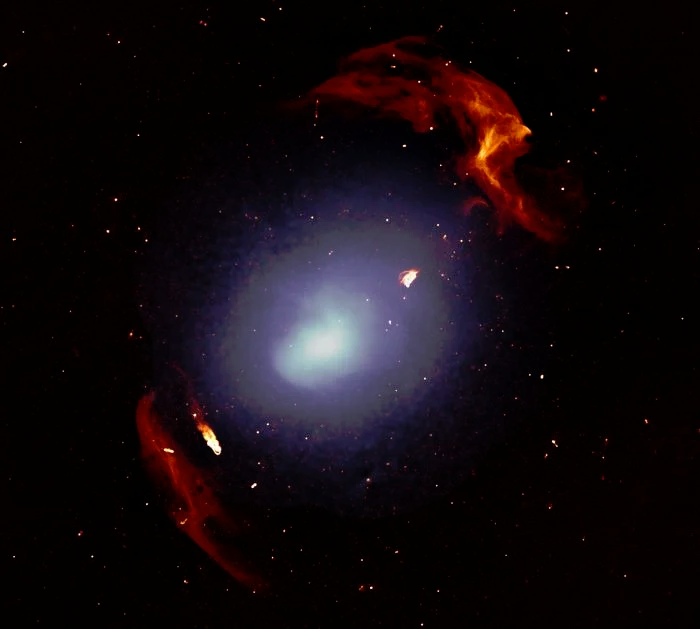Astronomers Find Planet Revolving Around Two Stars Simultaneously
Scientists crack origin of mysterious signal from another galaxy 12m light years away
Colossal Shock Wave Rippling Across Space Is Bigger Than Our Entire Galaxy
Supercomputers Simulated a Black Hole And Found Something We’ve Never Seen Before
Mind-Bending New Multiverse Scenario Could Explain a Strange Higgs Boson Feature
Loop quantum gravity: Does space-time come in tiny chunks?
HERA Telescope: Early Findings Promise Deeper Understanding of the Cosmic Dawn
Is the “Fine-Tuned Universe” an Illusion? Challenging Popular Arguments for a Multiverse
Astronomers Watch a Star Die and Then Explode as a Supernova – For the Very First Time
An Expanse of Light – Dazzling New Multiwavelength Images of the Universe From NASA
Resolving the gravitational redshift across a millimetre-scale atomic sample
Universe is Teeming with Quintillions of Stellar-Mass Black Holes
Anatomy of Milky Way’s Star Creation -Occurs in Skeletal Light-Years-Long Filaments
Dark-Matter Asteroids – “Trillions of Trillions May Exist in the Milky Way”
The Eerie Implications of the Multiverse
“Unsolved Mystery ” -Strange Particle from Deep Space Detected at Antarctica’s South Pole
Tiny new planet discovered around Sun’s nearest neighbor
James Webb Space Telescope snaps first images – a star and a selfie
First-ever “rogue” black hole discovered zipping through the galaxy
Bizarre radio signal repeating every 18 minutes discovered in Milky Way
Astronomers discover new type of star with puzzling origins
Scientists discover how galaxies can exist without dark matter
Future gravitational wave detector in space could uncover secrets of the universe
Astronomers find largest radio galaxy ever
Largest-ever 3D map of the universe reveals gigantic cosmic web
Is the universe’s dark matter hiding in primordial black holes?
Astronomers Discover a Strange Galaxy Without Dark Matter
The Physics of the James Webb Space Telescope
> Astronomers Find Planet Revolving Around Two Stars Simultaneously
Kepler planet discovered by occultation is confirmed by radial velocity. (No details in news report)
> Scientists crack origin of mysterious signal from another galaxy 12m light years away
The nearest fast radio burst is very similar to the signal from a magnetar.
> Colossal Shock Wave Rippling Across Space Is Bigger Than Our Entire Galaxy
When two galaxy clusters collide.

> Supercomputers Simulated a Black Hole And Found Something We’ve Never Seen Before
Magnetic reconnection, that’s interesting.
> Mind-Bending New Multiverse Scenario Could Explain a Strange Higgs Boson Feature
“physicists calculated how these universes would evolve over time. They found that universes with heavier Higgs bosons became unstable and collapsed very quickly in a big crunch. The universes with lighter Higgs bosons survived.”
Yes, we know this.
(What the heck! Somehow my keyboard @ and “ symbols have swapped position!)
> HERA Telescope: Early Findings Promise Deeper Understanding of the Cosmic Dawn
Hydrogen Epoch of Reionization Array (HERA), a radio telescope located at the South Africa Karoo Astronomy Reserve. Is this going to be part of the SKA?
> Astronomers Watch a Star Die and Then Explode as a Supernova – For the Very First Time
Yep, we discussed this. Even before the light from the supernova, the star outshone its parent galaxy in infrared.
> An Expanse of Light – Dazzling New Multiwavelength Images of the Universe From NASA
> Resolving the gravitational redshift across a millimetre-scale atomic sample
“we measure a linear frequency gradient consistent with the gravitational redshift within a single millimetre-scale sample of ultracold strontium. Our result is enabled by improving the fractional frequency measurement uncertainty by more than a factor of 10, now reaching 7.6 × 10^−21.”
> Universe is Teeming with Quintillions of Stellar-Mass Black Holes
One of the most fundamental quantities for demographic studies of the black hole population is constituted by the relic mass function, namely the number density of black holes per comoving volume and unit black hole mass, as a function of redshift. We provide an ab initio computation of the stellar black hole relic mass function across cosmic times, by coupling the state-of-the-art stellar and binary evolutionary code SEVN to redshift-dependent galaxy statistics and empirical scaling relations involving metallicity, star formation rate and stellar mass. The researchers estimate a relic mass density of stellar-mass black holes in the local Universe of 5*10^7 solar masses per cubic megaparsec, which exceeds by more than two orders of magnitude that in supermassive black holes.
> “Unsolved Mystery ” -Strange Particle from Deep Space Detected at Antarctica’s South Pole
We discussed this. Because the upward particles are from balloon experiments there is probably a mundane explanation. If found in on-ground or underground experiments then the results would be very important.
> Astronomers discover new type of star with puzzling origins
We discussed this. White dwarfs with atmosphere rich in carbon have been known for many decades.
> Scientists discover how galaxies can exist without dark matter
“when tiny galaxies collide with bigger ones, the bigger galaxies can strip the smaller galaxies of their dark matter”
Yes. There are some dwarf galaxies with more, and less, than the normal amount of dark matter in our local group.
> Future gravitational wave detector in space could uncover secrets of the universe
“LISA was first proposed as a mission to ESA in the early 1990s.” Delighted to see that LISA is still on the table as a new gravitational wave detector in space. Unimpressed that it’s planned launch date is still 16 years away.
> Data from the Dark Energy Spectroscopic Instrument’s (DESI’s) first survey run has produced the largest and most detailed 3D map of the universe so far.
> Is the universe’s dark matter hiding in primordial black holes?
No. That was disproved ages ago.